Introduction: Understanding LG Touchscreen Software in 2025
LG has established itself as a prominent manufacturer of commercial-grade touchscreen displays, offering hardware solutions that power interactive experiences across retail, education, corporate, and hospitality environments. However, when organizations evaluate LG touchscreen displays, a critical question emerges: what software will drive these impressive hardware installations?
This comprehensive guide explores LG touchscreen software options, capabilities, applications, and—importantly—how specialized software solutions can transform LG hardware into powerful interactive experiences that exceed what generic software platforms deliver.
LG Touchscreen Hardware Overview
Before diving into software considerations, understanding LG’s hardware offerings provides essential context for software selection decisions.
LG Commercial Display Technology
LG manufactures several touchscreen display lines for commercial applications:
LG Touch Overlay Series
- Infrared multi-touch technology supporting 10+ simultaneous touch points
- Available in sizes from 32" to 86"
- Anti-glare coating for high-visibility environments
- 24/7 operation rating for continuous-use applications
- Support for Windows, Android, and Linux operating systems
LG TouchSmart Series
- Capacitive touch technology delivering smartphone-like responsiveness
- 43" to 55" display options optimized for kiosk applications
- Edge-to-edge glass design for premium aesthetics
- Built-in content management capabilities through webOS
LG Interactive Digital Board
- 55" to 86" collaborative touchscreens designed for education and corporate meetings
- Stylus and palm-rejection technology for natural writing experiences
- Built-in whiteboarding and annotation software
- Screen-sharing and wireless presentation capabilities

Hardware Capabilities That Demand Quality Software
LG’s touchscreen hardware delivers impressive specifications that software must leverage effectively:
- 4K Ultra HD resolution requiring optimized content and interfaces
- Multi-touch gesture recognition needing software that interprets complex interactions
- Portrait and landscape orientation demanding responsive design approaches
- Anti-vandalism construction for public spaces requiring secure software lockdown
- Low-power operation modes best managed through intelligent software control
These hardware capabilities create opportunities—but only when paired with software designed to exploit them fully.
LG Software Options: Native and Third-Party Solutions
Organizations implementing LG touchscreen displays face several software pathway options, each with distinct advantages and limitations.
webOS Signage Platform
LG’s proprietary webOS signage platform provides basic interactive capabilities for their commercial displays.
Key Features:
- Built-in content management for digital signage applications
- Web-based content delivery and scheduling
- Remote device monitoring and management
- Template-based content creation tools
- HTML5 app support for custom development
Limitations for Interactive Applications:
- Primarily designed for broadcast signage rather than interactive kiosks
- Limited touch interaction capabilities beyond basic navigation
- Requires web development expertise for custom experiences
- No specialized features for recognition displays or educational applications
- Basic analytics compared to dedicated interactive platforms

LG Cre
ateBoard Interactive Software
For LG’s interactive digital board products, CreateBoard software provides collaborative features for education and business applications.
Capabilities:
- Digital whiteboarding with drawing and annotation tools
- Multi-user collaboration support
- Content import from various file formats
- Cloud storage integration for saving and sharing work
- Video conferencing integration
Best Applications:
- Classroom instruction and student collaboration
- Corporate meeting rooms and brainstorming sessions
- Design review and markup workflows
Limitations:
- Focused specifically on collaborative whiteboarding use cases
- Not designed for public-facing kiosk or recognition display applications
- Requires user familiarity with collaborative software paradigms
- Limited content management for static information displays
Third-Party Windows and Android Applications
LG touchscreen displays running Windows or Android operating systems support thousands of third-party software applications, creating both opportunities and challenges.
Popular Categories:
- Kiosk lockdown software restricting device access to approved applications
- Digital signage platforms managing content across multiple displays
- Point-of-sale systems for retail and hospitality environments
- Wayfinding applications providing interactive maps and directions
- Educational software delivering lessons and assessments
The breadth of available software creates flexibility but demands careful evaluation to identify solutions matching specific organizational needs.
The Software Selection Challenge for LG Displays
While LG manufactures exceptional touchscreen hardware, organizations quickly discover that hardware excellence alone doesn’t guarantee successful interactive installations. The software layer determines user experience quality, content management efficiency, and long-term operational success.
Common Implementation Challenges
Organizations implementing LG touchscreen displays frequently encounter these software-related obstacles:
Technical Complexity
- Many platforms require coding expertise for customization
- Integration with existing systems demands technical resources
- Updates and maintenance require IT department involvement
- Troubleshooting issues necessitates specialized knowledge
Generic Approaches
- General-purpose software lacks specialized features for specific applications
- Template-based solutions feel impersonal and generic
- Limited customization options restrict brand expression
- One-size-fits-all interfaces don’t optimize for target audiences
Content Management Burden
- Complex content management systems overwhelm non-technical staff
- Updating information requires excessive time and expertise
- Multi-location management becomes administratively challenging
- No streamlined workflows for common content update scenarios
Insufficient Analytics
- Basic or non-existent usage tracking
- No insights into user engagement patterns
- Difficulty demonstrating return on investment
- Limited ability to optimize experiences based on data
These challenges explain why many organizations with impressive LG touchscreen hardware struggle to achieve exceptional interactive experiences—the software doesn’t match the hardware’s capabilities.
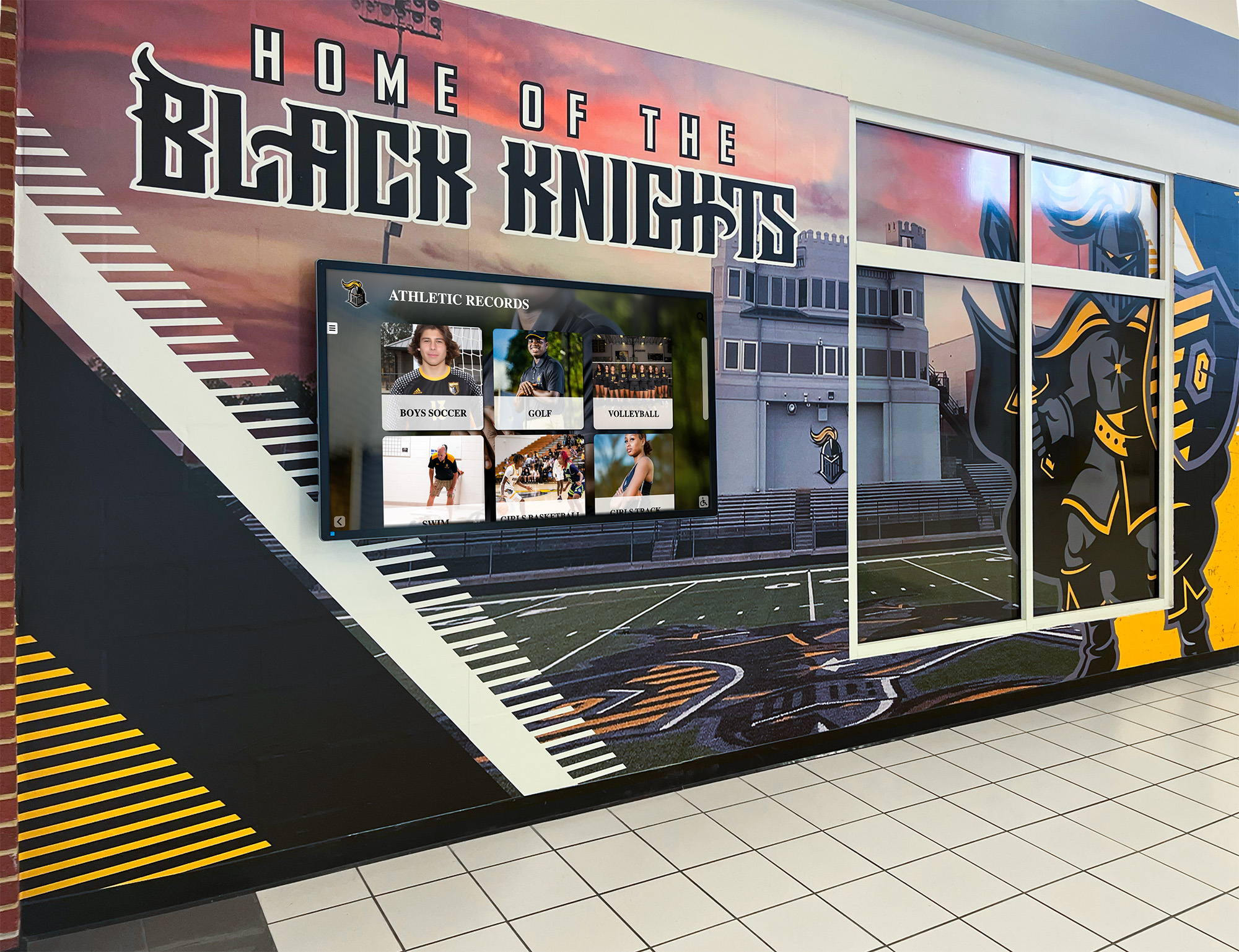
Specialized Software Solutions for LG Displays
For organizations implementing LG touchscreen displays in educational, recognition, and institutional applications, specialized software platforms deliver dramatically superior results compared to generic alternatives.
Rocket Alumni Solutions: Purpose-Built Excellence
While LG provides outstanding touchscreen hardware, solutions like Rocket Alumni Solutions offer specialized software platforms optimized specifically for recognition displays, hall of fame installations, donor walls, and achievement showcases that frequently leverage LG displays.
Why Specialized Software Matters:
Traditional digital signage or generic kiosk software treats every application identically. Specialized platforms like Rocket Alumni Solutions understand the unique requirements of recognition and educational displays:
- Achievement-Focused Features including biography management, category organization, and timeline visualization
- Multimedia Storytelling seamlessly integrating photos, videos, and documents into engaging narratives
- Search and Discovery enabling visitors to explore hundreds or thousands of entries intuitively
- Mobile Integration connecting physical displays to personal devices for extended engagement
- Accessibility Compliance ensuring inclusive experiences meeting ADA requirements
No-Code Content Management
Perhaps the most significant advantage of specialized solutions involves content management accessibility. While generic platforms require technical expertise, specialized solutions provide intuitive interfaces allowing any staff member to:
- Add new inductees or achievements with simple forms
- Upload and organize multimedia content through drag-and-drop interfaces
- Schedule content publication for future dates
- Moderate user-submitted content efficiently
- Update information across multiple displays simultaneously
This accessibility dramatically reduces operational costs and enables organizations to keep content current without ongoing IT support.

Key Advantages of Specialized Interactive Software
Organizations implementing recognition and achievement displays on LG touchscreen hardware gain substantial benefits from specialized software platforms:
1. Educational Focus and Understanding
Specialized platforms understand educational environments, offering features like:
- Student privacy controls and approval workflows
- Academic year organization and graduation class grouping
- Sport and activity categorization systems
- Season and championship recognition structures
- Faculty and coach tribute capabilities
Generic platforms require extensive customization to support these fundamental educational requirements.
2. Engagement Optimization
Recognition displays succeed when visitors engage deeply with content. Specialized platforms optimize engagement through:
- Intuitive navigation designed for infrequent users of all ages
- Featured content highlighting recent inductees and accomplishments
- Related content suggestions encouraging exploration
- Social sharing integrations extending reach beyond physical displays
- Interactive timelines and visualization modes
3. Scalability and Multi-Location Support
Educational institutions and organizations frequently expand successful recognition displays to additional locations. Specialized platforms facilitate scalability through:
- Centralized content management across unlimited displays
- Location-specific content customization while maintaining brand consistency
- Bulk import capabilities for large historical datasets
- Template systems ensuring visual consistency
- Role-based permissions supporting distributed content management
4. Analytics and Insights
Understanding how visitors interact with recognition displays informs content strategy and demonstrates value. Specialized platforms provide:
- Detailed engagement metrics tracking popular content
- Search query analysis revealing visitor interests
- Session duration and return visitor tracking
- Heat maps showing attention patterns
- Time-of-day usage analysis optimizing content scheduling
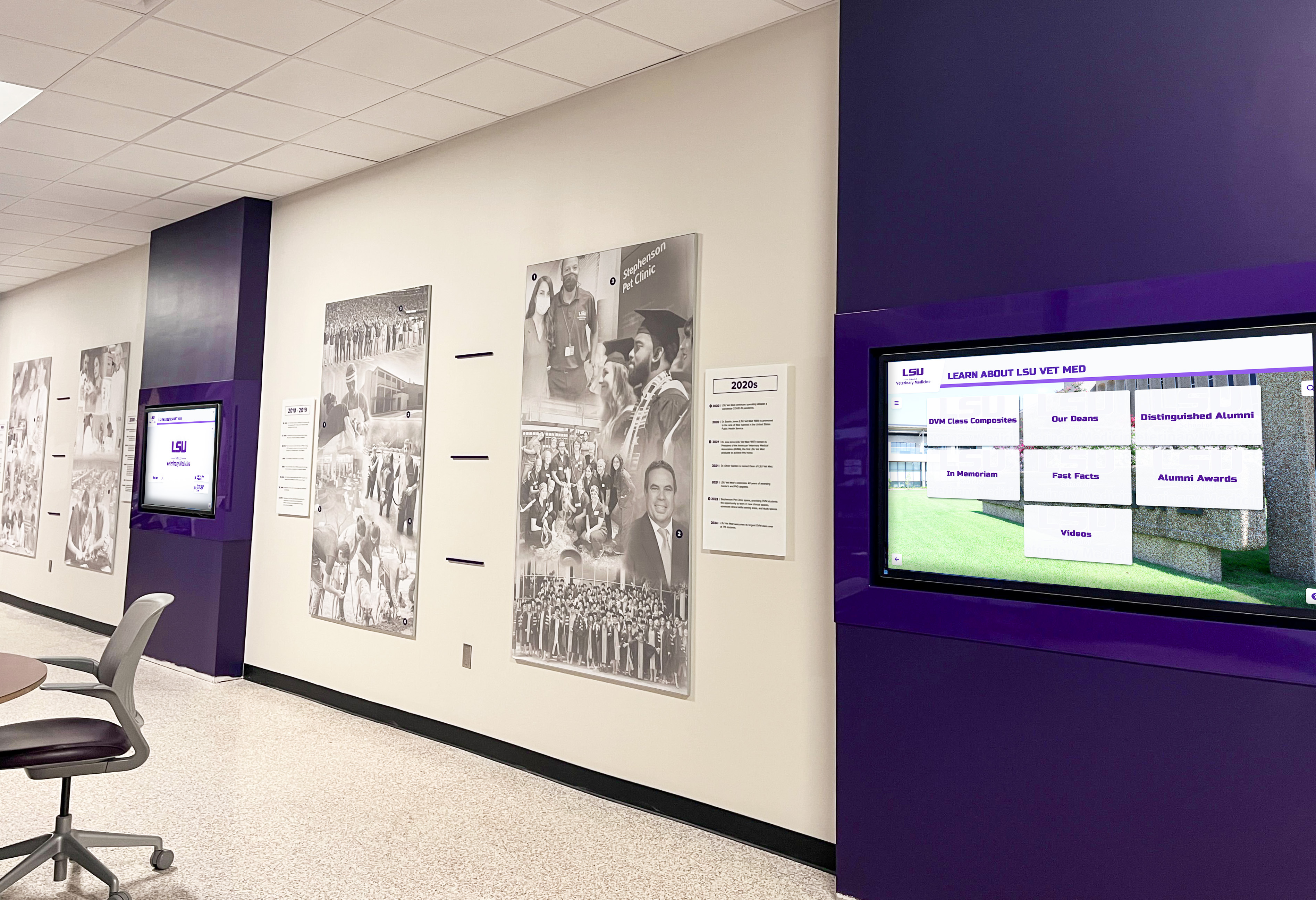
Implementation Considerations for LG Touchscreen Software
Successfully implementing interactive software on LG touchscreen displays requires careful planning addressing technical, content, and operational considerations.
Technical Requirements Assessment
Display Configuration
- Determine optimal portrait or landscape orientation for your space and content
- Verify network connectivity options (ethernet strongly preferred for reliability)
- Assess mounting requirements and viewing angles
- Consider ambient lighting and potential glare issues
- Plan power requirements and surge protection
Operating System Selection
- Windows offers broadest software compatibility and enterprise management
- Android provides lower hardware costs and simpler deployment
- webOS delivers integrated management for LG-native solutions
- Linux supports open-source and highly customized implementations
Integration Needs
- Identify existing systems requiring integration (student information systems, CRM platforms, etc.)
- Determine authentication and single sign-on requirements
- Plan for mobile app connections if desired
- Consider payment processing if accepting donations or selling items
Content Strategy Development
Successful interactive displays require thoughtful content planning before software implementation begins.
Information Architecture
- Organize content into logical categories and hierarchies
- Design navigation paths supporting different visitor goals
- Balance depth of information with ease of access
- Plan search and filtering capabilities
- Consider multilingual requirements for diverse audiences
Content Creation and Migration
- Inventory existing recognition records requiring digitization
- Establish biographical information standards and templates
- Develop photo and video collection workflows
- Create compelling written narratives highlighting achievements
- Build content approval processes ensuring accuracy
For organizations digitizing extensive historical records, resources like software solutions for education records digitization provide valuable guidance on efficient approaches.
Maintenance Planning
- Define content update schedules and responsibilities
- Establish quality standards for text, images, and videos
- Create user submission and moderation workflows
- Plan for regular content audits and refreshes
- Document procedures for common content management tasks

User Experience Design Principles
LG touchscreen displays support sophisticated interactions, but effective experiences follow fundamental user experience principles:
Touch Target Sizing
- Minimum 44×44 pixel (9mm) touch targets for accessibility
- Adequate spacing preventing accidental adjacent activation
- Clear visual boundaries indicating interactive elements
- Consistent placement of navigation controls
Visual Hierarchy
- Prominent display of most important information
- Progressive disclosure of detailed content
- Sufficient contrast for readability at viewing distances
- Consistent typography and color palette
Response Time and Feedback
- Immediate visual feedback confirming touch registration
- Loading indicators for content requiring retrieval
- Smooth transitions between screens and content
- Clear messaging for errors or unavailable information
Accessibility Considerations
- Text sizing controls for vision-impaired users
- Screen reader compatibility for blind visitors
- Color contrast meeting WCAG guidelines
- Alternative input methods for users unable to touch displays
Organizations seeking comprehensive information about touchscreen kiosk software features and best practices will find detailed implementation guidance valuable.
Industry Applications of LG Touchscreen Displays
LG touchscreen hardware serves diverse industries, with software requirements varying dramatically based on application context.
Educational Institutions
Schools, colleges, and universities represent the largest user base for interactive recognition displays on LG touchscreen hardware.
Common Applications:
- Athletic halls of fame showcasing championship teams and standout athletes
- Academic achievement walls recognizing valedictorians and scholars
- Alumni directories celebrating notable graduates
- Donor recognition displays honoring supporters
- Campus directories and wayfinding systems
- Digital record boards displaying athletic achievements
Software Requirements:
- Intuitive interfaces accessible to students, staff, and visitors
- Privacy controls protecting student information
- Integration with existing school databases
- Mobile apps extending engagement beyond physical displays
- Analytics demonstrating community impact
Educational institutions benefit particularly from specialized software understanding academic calendars, sports seasons, and school structures—features generic platforms lack.
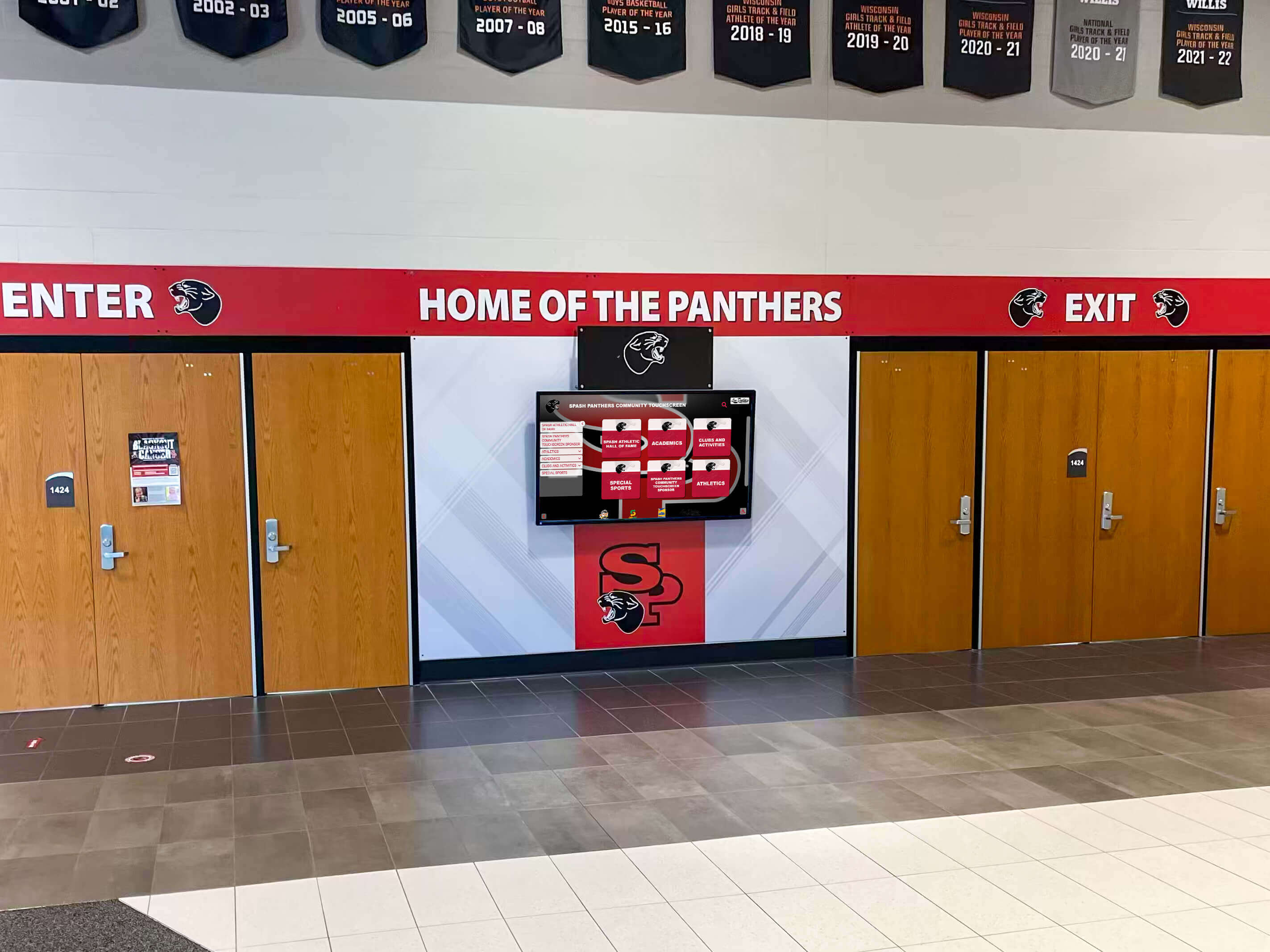
Corporate Recognition
Businesses implement LG touchscreen displays for employee recognition, corporate history, and visitor information applications.
Typical Use Cases:
- Employee milestone and achievement recognition
- Retirement and service anniversary tributes
- Sales performance leaderboards
- Corporate timeline and history displays
- Visitor management and wayfinding
- Product showcase and information kiosks
Critical Software Features:
- Professional aesthetic matching corporate branding
- Integration with HR systems for automated updates
- Security controls protecting sensitive information
- Analytics demonstrating employee engagement
- Multi-location management for distributed organizations
Museums and Cultural Institutions
Cultural organizations leverage LG touchscreen displays to enhance visitor experiences and provide contextual information about collections.
Common Implementations:
- Interactive exhibit information and multimedia content
- Collection search and discovery interfaces
- Virtual tours and augmented experiences
- Donor and sponsor recognition
- Membership information and enrollment
- Event calendars and program descriptions
Essential Software Capabilities:
- Rich multimedia support including high-resolution images and video
- Multilingual interfaces serving diverse audiences
- Offline operation capabilities for network-limited environments
- Accessibility features ensuring inclusive experiences
- Analytics tracking popular exhibits and visitor patterns
Healthcare Facilities
Medical environments deploy LG touchscreen displays for patient information, wayfinding, and healthcare provider directories.
Primary Applications:
- Patient check-in and registration kiosks
- Hospital and medical campus wayfinding
- Healthcare provider directories and credentials
- Health information and education resources
- Appointment scheduling and management
- Patient satisfaction surveys
Required Software Features:
- HIPAA compliance protecting patient privacy
- Sanitization-friendly interfaces minimizing touch requirements
- Clear navigation for stressed and distracted users
- Accessibility features for diverse patient populations
- Integration with existing healthcare information systems
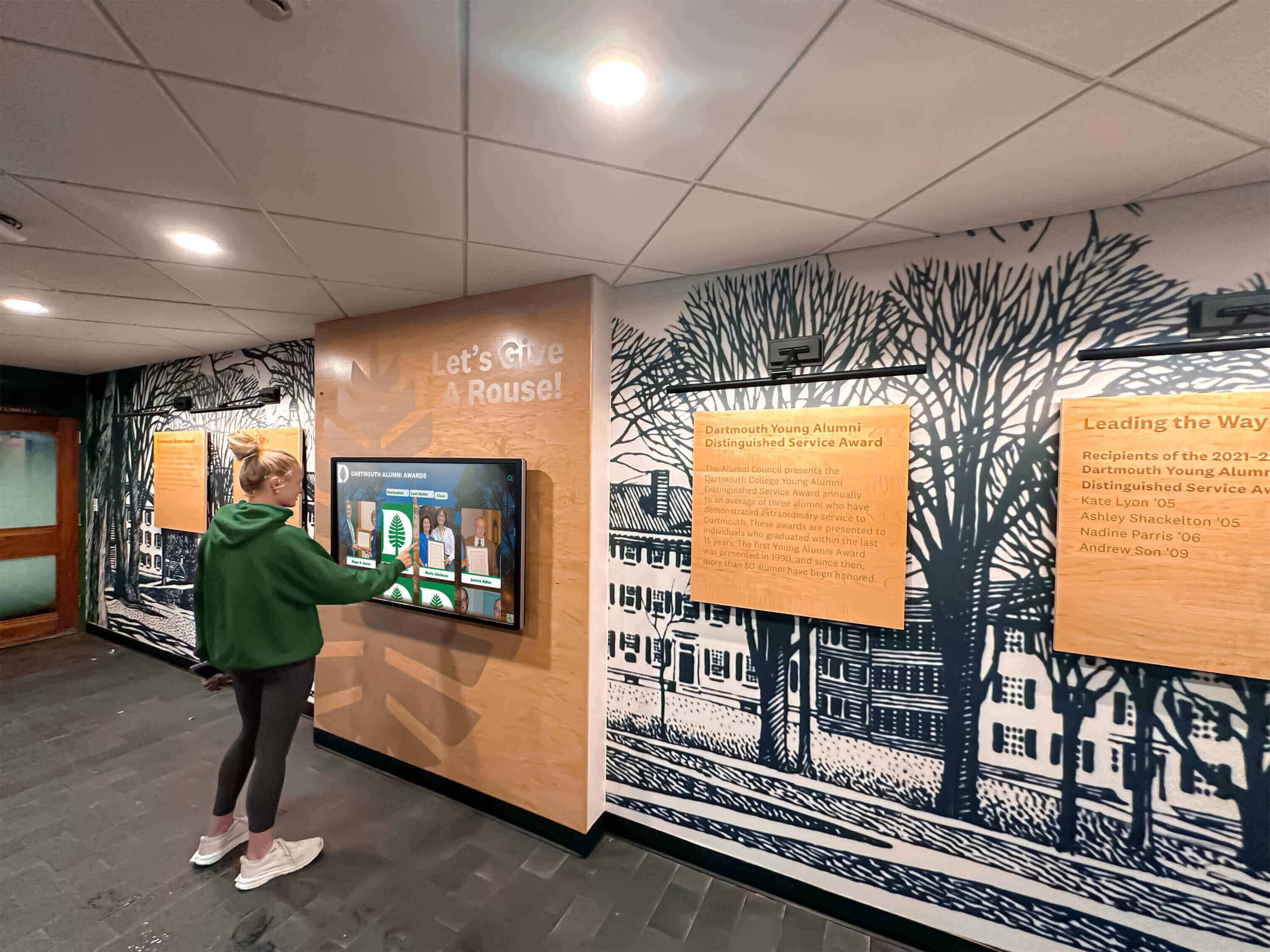
Comparing Generic and Specialized Software Approaches
Understanding the fundamental differences between generic and specialized software platforms helps organizations make informed decisions for their LG touchscreen implementations.
Generic Digital Signage and Kiosk Platforms
Strengths:
- Broad feature sets supporting diverse applications
- Established vendor ecosystems and support resources
- Lower upfront costs for basic functionality
- Flexibility for custom development projects
- Support for multiple hardware manufacturers
Limitations:
- Require technical expertise for configuration and maintenance
- Lack specialized features for specific industries and applications
- Generic templates feeling impersonal and corporate
- Complex content management overwhelming non-technical staff
- Limited optimization for specific use cases like recognition displays
Best Applications:
- Organizations with substantial IT resources
- Multi-purpose display networks supporting various content types
- Retail and hospitality applications with transaction requirements
- Environments requiring extensive third-party integrations
Specialized Recognition and Educational Platforms
Strengths:
- Purpose-built features optimized for specific applications
- Intuitive content management requiring minimal training
- Educational and institutional understanding
- Engaging user experiences designed for target audiences
- Comprehensive support and implementation services
Considerations:
- Focused on specific application categories
- May require integration work for extensive enterprise system connections
- Specialized vendors may have smaller ecosystems than major platforms
Ideal Applications:
- Educational institutions implementing recognition displays
- Organizations without extensive IT resources
- Projects prioritizing user experience and engagement
- Environments requiring frequent content updates by non-technical staff
- Multi-location deployments benefiting from centralized management
For detailed comparisons of touchscreen software solutions, organizations will find comprehensive feature evaluations and selection guidance valuable.
Future Trends in LG Touchscreen Software
The interactive display landscape continues evolving rapidly, with several emerging trends shaping future software development.
Artificial Intelligence Integration
AI capabilities are enhancing touchscreen experiences through:
- Personalized content recommendations based on interaction history and patterns
- Natural language search understanding visitor intent beyond keyword matching
- Voice interaction supplementing touch for accessibility and convenience
- Computer vision enabling gesture recognition and attention tracking
- Automated content optimization adjusting layouts based on engagement data
Cloud-Native Architecture
Modern touchscreen software increasingly adopts cloud-first approaches delivering:
- Automatic updates deploying new features without on-site intervention
- Centralized management controlling unlimited displays from single interfaces
- Scalability supporting organizational growth without infrastructure changes
- Remote monitoring identifying and resolving issues proactively
- Disaster recovery protecting content and configurations automatically
Mobile Integration and Hybrid Experiences
The boundary between physical displays and personal devices continues blurring:
- QR code connections transferring content from displays to mobile devices
- Mobile companion apps extending engagement beyond physical locations
- Social media integration enabling content sharing and extending reach
- Personal collections allowing users to save and organize favorite content
- Notifications alerting users to new content matching their interests
Enhanced Accessibility Features
Inclusive design principles are driving software development:
- Voice narration describing visual content for blind visitors
- Adjustable interfaces accommodating various visual and motor capabilities
- Simplified navigation modes reducing cognitive load
- Multiple language support serving diverse communities
- Keyboard and switch access enabling alternative input methods
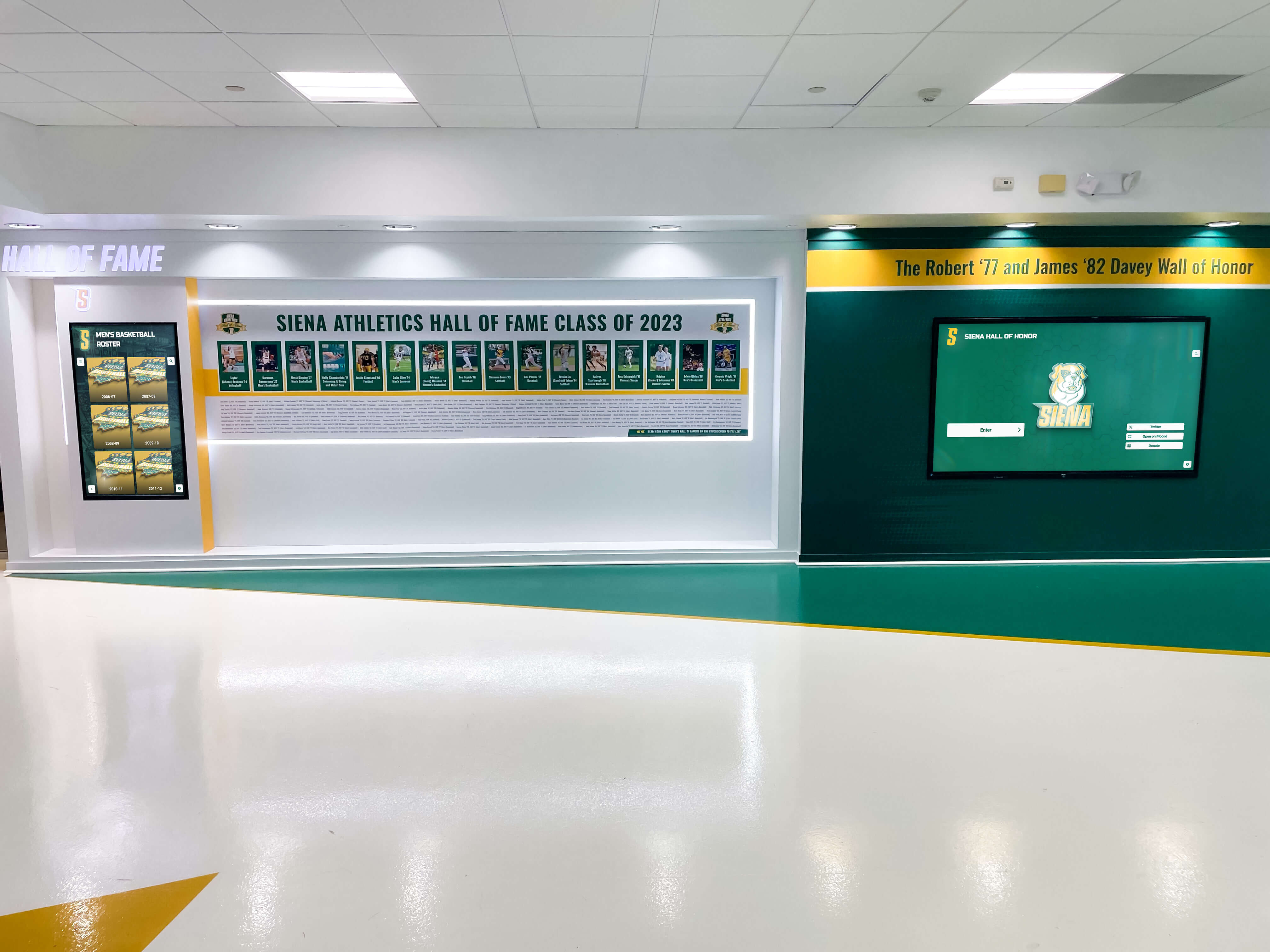
Selection Criteria: Choosing Software for LG Displays
Organizations evaluating software options for LG touchscreen displays should assess candidates against these critical criteria.
Ease of Use and Content Management
Key Questions:
- Can non-technical staff update content independently?
- How long does training require for content managers?
- Does the platform provide templates streamlining common tasks?
- Can content be scheduled for future publication?
- Does the system support bulk imports for large datasets?
Feature Alignment with Application Requirements
Critical Considerations:
- Does the software optimize for your specific use case (recognition, wayfinding, information, etc.)?
- Are specialized features available for your industry and needs?
- Can the platform scale as your requirements evolve?
- Does the software support required multimedia formats?
- Are analytics provided matching your measurement goals?
Total Cost of Ownership
Cost Components to Evaluate:
- Initial licensing and implementation fees
- Ongoing subscription or maintenance costs
- Hardware compatibility and requirements
- Staff training and ongoing support
- Customization and integration expenses
- Content development and migration costs
Vendor Support and Partnership Quality
Important Factors:
- Implementation assistance and project management services
- Technical support responsiveness and expertise
- Documentation quality and training resources
- Regular feature enhancements and updates
- Client references and proven track record
- Company stability and longevity
Integration and Technical Capabilities
Technical Requirements:
- Compatibility with your LG display models
- Operating system requirements and flexibility
- API availability for system integrations
- Security features and compliance certifications
- Offline operation capabilities
- Remote management and monitoring tools
Implementation Best Practices for LG Touchscreen Displays
Successful interactive display implementations follow proven best practices addressing planning, deployment, and ongoing operations.
Project Planning Phase
Define Clear Objectives
- Articulate specific goals the interactive display should accomplish
- Identify target audiences and their needs
- Establish success metrics and measurement approaches
- Determine budget parameters and timeline expectations
- Secure stakeholder buy-in and support
Conduct Site Assessment
- Evaluate physical locations for displays
- Assess ambient lighting and viewing angles
- Verify network connectivity and power availability
- Consider traffic patterns and visitor flows
- Plan for physical security and protection
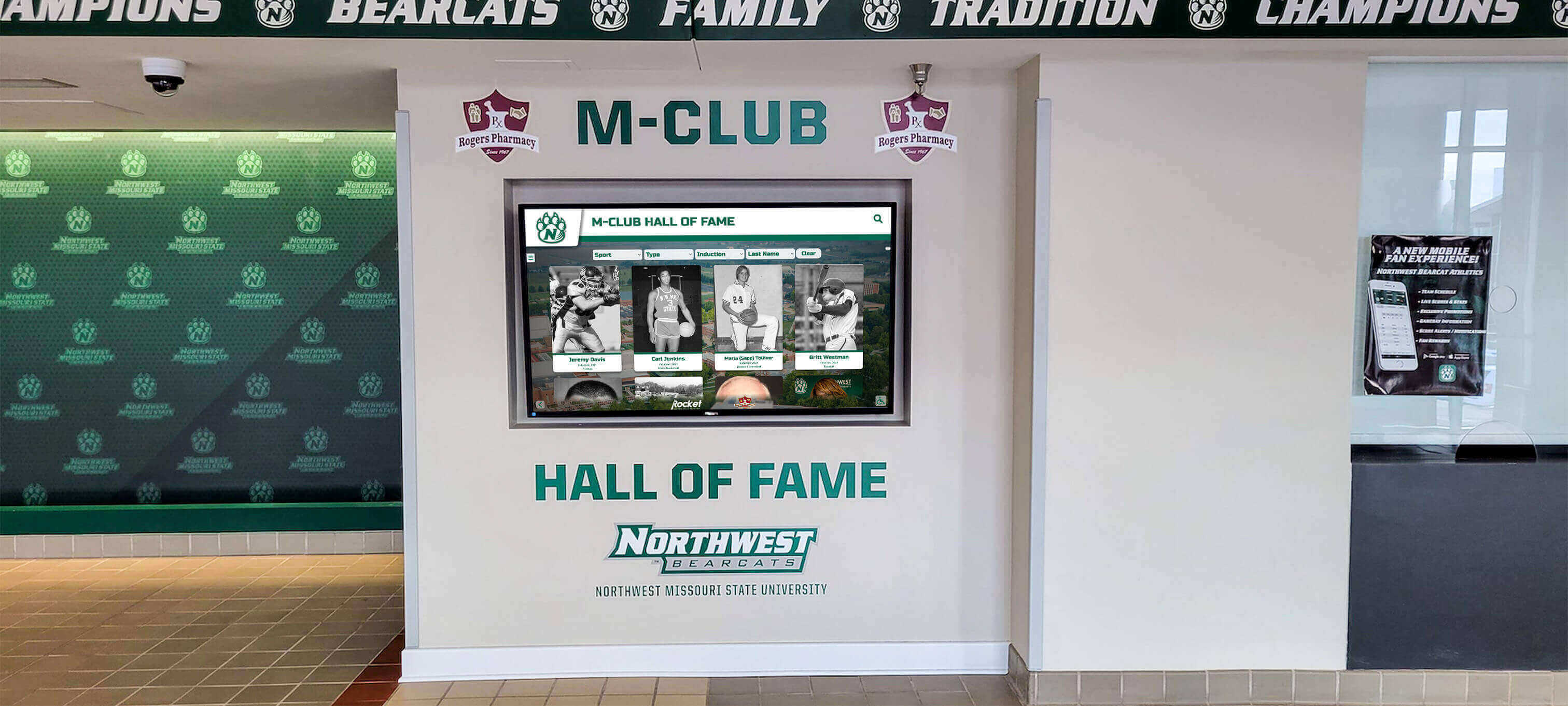
Content Development Strategy
Content Inventory and Creation
- Catalog existing content requiring migration
- Establish biographical and informational standards
- Create content templates ensuring consistency
- Develop photo and video collection workflows
- Build approval processes maintaining quality
Information Architecture Design
- Organize content into intuitive categories
- Design navigation supporting visitor goals
- Create search and filtering capabilities
- Plan content depth and detail levels
- Consider multilingual requirements
Testing and Launch
Comprehensive Testing Protocol
- User acceptance testing with representative visitors
- Performance testing under realistic load conditions
- Accessibility testing with assistive technologies
- Content proofing for accuracy and quality
- Security testing protecting against unauthorized access
Phased Launch Approach
- Pilot implementation in limited locations
- Gather user feedback and make adjustments
- Document lessons learned and best practices
- Expand to additional locations systematically
- Maintain launch momentum through promotion
Ongoing Operations and Optimization
Regular Content Updates
- Establish update schedules and responsibilities
- Maintain content freshness and relevance
- Feature recent achievements and inductees prominently
- Rotate highlighted content periodically
- Archive or remove outdated information
Performance Monitoring and Analytics
- Review usage metrics regularly
- Identify popular and ignored content
- Analyze visitor navigation patterns
- Measure achievement of defined objectives
- Adjust content and experiences based on insights
Maintenance and Support
- Schedule regular hardware cleaning and inspection
- Monitor software performance and availability
- Address user-reported issues promptly
- Apply software updates and security patches
- Maintain documentation of configurations and procedures
Conclusion: Maximizing LG Touchscreen Display Value Through Software Excellence
LG manufactures exceptional touchscreen display hardware capable of delivering extraordinary interactive experiences across educational, corporate, and institutional applications. However, hardware excellence alone doesn’t guarantee successful implementations—the software layer determines whether installations achieve their full potential or deliver disappointing results.
Organizations face a critical software selection decision. Generic digital signage and kiosk platforms offer broad capabilities but require substantial technical expertise, lack specialized features for specific applications, and demand significant customization to deliver engaging experiences. These platforms serve certain use cases well but frequently disappoint organizations seeking turnkey solutions for recognition displays, hall of fame installations, and educational applications.
Specialized software platforms purpose-built for specific applications deliver dramatically superior results. Solutions like Rocket Alumni Solutions understand the unique requirements of recognition and achievement displays, offering intuitive content management, engaging user experiences, and specialized features that generic platforms cannot match. When paired with LG’s impressive touchscreen hardware, specialized software transforms quality displays into exceptional interactive experiences that engage visitors, celebrate accomplishments, and demonstrate organizational values.
Whether implementing a single display or a network spanning multiple locations, the software selection determines long-term success. Organizations should prioritize solutions offering:
- Intuitive content management empowering non-technical staff
- Purpose-built features optimized for specific applications
- Engaging user experiences designed for target audiences
- Comprehensive support ensuring successful implementations
- Scalable architecture supporting organizational growth
The investment in quality LG touchscreen hardware deserves equally excellent software. Organizations committed to exceptional interactive experiences should evaluate specialized platforms delivering the features, usability, and support their projects require.
Ready to transform your LG touchscreen displays into powerful interactive experiences? Explore Rocket Alumni Solutions to discover how specialized software can maximize your hardware investment and deliver exceptional recognition displays that engage your community and celebrate achievements effectively.

































